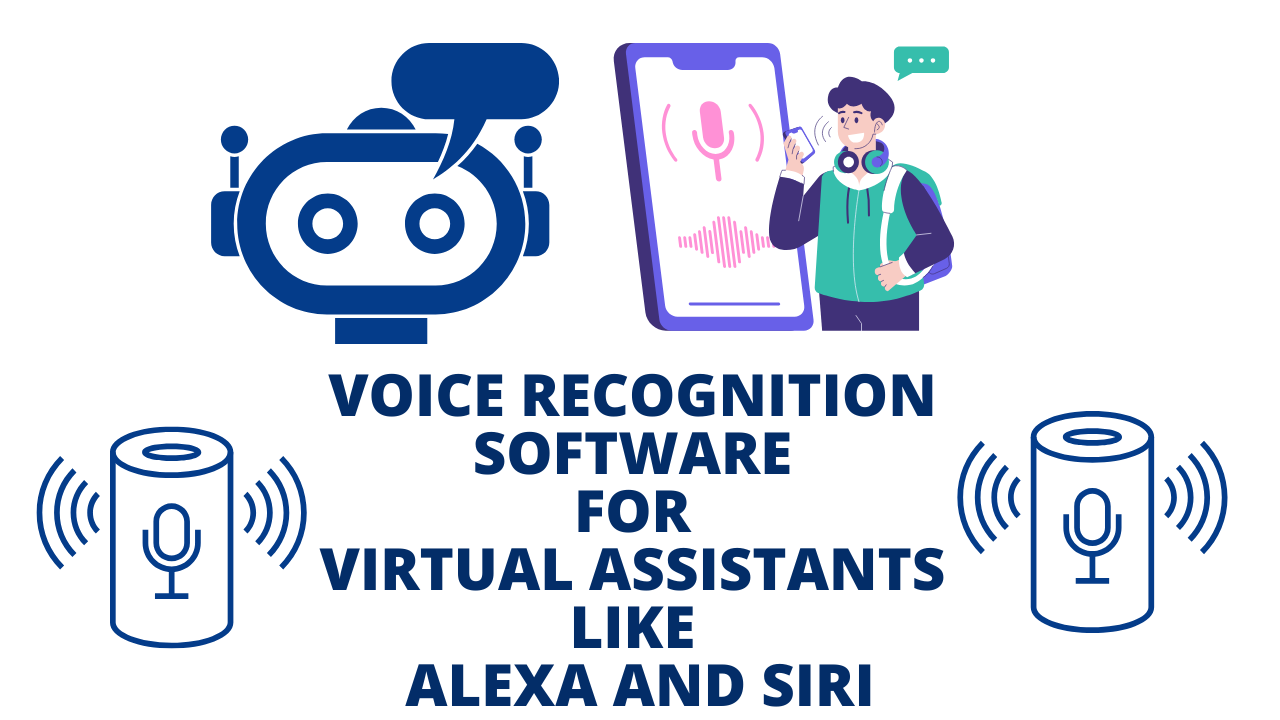In today’s world, voice recognition software has become an integral part of our daily lives, particularly in the form of virtual assistants like Amazon’s Alexa, Apple’s Siri, and Google Assistant. These technologies, powered by sophisticated voice recognition algorithms, enable us to perform tasks, control devices, and access information simply by speaking. This natural language processing (NLP) technology is transforming how we interact with our smartphones, smart homes, cars, and even workplace environments.
In this article, we will explore the role of voice recognition software in virtual assistants, the underlying technology that powers them, the benefits and challenges they present, and the future of voice-activated systems.
What Is Voice Recognition Software?
Voice recognition software refers to technology that allows computers or devices to recognize and respond to spoken language. These systems convert spoken words into machine-readable text and then process the commands to produce the desired output. Voice recognition is a subset of natural language processing (NLP), which is a field of artificial intelligence (AI) concerned with enabling machines to understand, interpret, and generate human language.
In virtual assistants like Alexa, Siri, and Google Assistant, voice recognition technology enables users to interact with their devices hands-free, enhancing convenience, productivity, and accessibility.
How Voice Recognition Software Works in Virtual Assistants
Virtual assistants like Alexa and Siri rely on complex voice recognition software to understand user commands and perform actions. Here’s an overview of how this technology works in these popular virtual assistants:
Voice Input and Sound Detection
When a user speaks to a virtual assistant, the first step is voice input, captured by the microphone on the device (whether it’s a smartphone, smart speaker, or other voice-activated device). The assistant listens for a trigger word or wake word (e.g., “Alexa” or “Hey Siri”) to activate its listening mode.
Once the wake word is detected, the system begins processing the speech signal in real-time. The sound wave generated by the user’s voice is converted into an electrical signal, which is then digitized and sent to the cloud for further analysis.
Speech-to-Text Conversion
The digital audio is then passed through a speech-to-text (STT) engine, which converts the audio signal into text. The accuracy of this step is critical, as even slight misinterpretations can lead to incorrect responses. The STT system typically uses deep learning algorithms, trained on large datasets of human speech, to accurately transcribe spoken words.
For virtual assistants to recognize speech accurately, they rely on complex machine learning models that can decipher various accents, languages, dialects, and even noisy environments.
Natural Language Understanding (NLU)
Once the speech is transcribed into text, it enters the Natural Language Understanding (NLU) phase. NLU is a branch of NLP that focuses on extracting meaning from human language. The system analyzes the transcribed text, identifying key components like intent (what the user wants to do), entities (specific data or objects mentioned, like a date or place), and context (understanding the broader situation surrounding the request).
For example, if you ask, “What’s the weather in New York tomorrow?” the NLU system will identify that the user wants to know about the weather (intent) in New York (entity) tomorrow (context). The NLU model also takes into account past interactions to better understand the request.
Action or Response Generation
Once the system understands the user’s command, it communicates with the relevant backend systems or APIs to fulfill the request. If you’re asking Alexa to play a song or Siri to set an alarm, the virtual assistant connects to streaming services or internal device systems to perform the action.
After the action is completed, the assistant generates a spoken response and delivers it back to the user. This text-to-speech (TTS) conversion allows the assistant to provide a spoken reply, completing the loop.
Continuous Learning
Voice recognition systems like Siri and Alexa continually improve by learning from user interactions. The more they process, the better they get at recognizing unique speech patterns, accents, and intents. For example, they can adapt to the user’s speech style over time, becoming better at interpreting specific commands and refining the accuracy of responses.
Benefits of Voice Recognition Software for Virtual Assistants
Voice recognition software in virtual assistants brings a wide array of benefits for users, ranging from convenience to accessibility. Let’s examine some of the key advantages:
Hands-Free Control
One of the primary advantages of voice recognition in virtual assistants is the ability to operate devices hands-free. This feature is especially useful when users are engaged in other tasks, such as cooking, driving, or exercising. Simply saying “Hey Siri” or “Alexa, set a reminder for 3 PM” allows users to multitask and manage their time more efficiently.
Increased Accessibility
Voice recognition also plays a critical role in improving accessibility for individuals with disabilities. For those with physical impairments, voice assistants allow them to interact with their devices and control their environments without the need for touch or visual inputs. Additionally, individuals with visual impairments can use voice assistants to navigate the web, make phone calls, and perform other tasks that would otherwise be challenging.
Enhanced Convenience
Voice assistants powered by voice recognition make everyday tasks more convenient. You can quickly check the weather, play music, set alarms, get directions, or control smart home devices with simple voice commands. The seamless integration of these assistants into daily life has transformed how we interact with technology.
Improved Productivity
For businesses and professionals, virtual assistants can help improve productivity. For instance, Siri and Alexa can schedule appointments, send messages, set reminders, and even manage meetings. In customer service, voice recognition technology is used to automate call routing, answer frequently asked questions, and enhance overall support services, freeing up time for human agents to address more complex issues.
Personalization and Context-Aware Responses
Virtual assistants learn from their interactions with users, allowing them to provide more personalized and context-aware responses over time. For example, Siri can recognize your daily routine and suggest relevant reminders or news updates, while Alexa can recommend music based on your previous listening habits. This personalization improves the overall user experience and makes interactions more efficient.
Challenges of Voice Recognition Software in Virtual Assistants
While the benefits of voice recognition are numerous, there are also challenges that come with using this technology in virtual assistants.
Speech Recognition Accuracy
One of the most significant challenges is ensuring that voice recognition software can accurately interpret a wide range of accents, dialects, and speech patterns. Users with thick accents or those speaking in noisy environments may experience issues with voice recognition accuracy. As a result, virtual assistants may misinterpret commands or fail to recognize certain words.
Privacy Concerns
Voice recognition technology inherently raises privacy concerns. Since most voice assistants rely on cloud-based processing, user data is often sent to remote servers for processing, which can raise questions about how personal information is stored and used. Major companies like Amazon, Apple, and Google have implemented security measures to protect user data, but concerns over unauthorized data collection and surveillance persist.
Dependency on Internet Connectivity
Many virtual assistants require an active internet connection to function optimally. If the device is offline or the network connection is weak, the assistant may not be able to perform certain tasks, such as retrieving information from the web or interacting with online services. Although some features are available offline, many rely on cloud-based services for real-time data processing.
Limited Multitasking Capabilities
While voice assistants are useful for handling single tasks, they still face challenges when it comes to multitasking. For example, trying to issue two commands at once—such as asking Siri to set a reminder while playing music—can confuse the system.
Security Risks
Virtual assistants like Alexa and Siri are often integrated with smart home devices, making them potential targets for hackers. If not properly secured, these systems could become vulnerable to malicious attacks. There have been instances of unauthorized access to voice assistant accounts, making it critical for users to implement strong security measures, such as two-factor authentication.
The Future of Voice Recognition in Virtual Assistants
The future of voice recognition software in virtual assistants is full of potential. We can expect to see continuous improvements in accuracy, security, and functionality. Here are a few trends to watch for in the coming years:
Better Contextual Understanding
Future voice assistants will likely be better at understanding context and intent. By processing a user’s history and ongoing conversation, these assistants will offer more intelligent responses. For instance, they may be able to understand the context of a query by remembering previous conversations, allowing for a more seamless interaction.
Multilingual Support
As voice recognition systems improve, we can expect them to support a wider variety of languages, accents, and dialects. This will make virtual assistants more accessible to a global audience and provide more accurate responses to non-native speakers.
Integration with More Devices
The growth of the Internet of Things (IoT) means that voice assistants will become even more integrated with everyday devices, from kitchen appliances to cars and health monitoring systems. The future will see seamless, voice-activated interactions across a broad range of smart devices, creating a more connected and automated environment.
Increased Security Features
With increasing concerns over privacy and security, voice recognition technology will likely evolve to include better encryption and authentication measures. Innovations in biometric voice recognition may allow for voice-based security features, making it more difficult for unauthorized users to gain access to devices and accounts.
Conclusion
Voice recognition software is a transformative technology, reshaping the way we interact with virtual assistants like Alexa and Siri. By enabling hands-free control, improving accessibility, and enhancing convenience, it is becoming an essential part of our digital lives. As the technology continues to evolve, we can expect even more sophisticated features, making voice assistants an even more integral part of our daily routines. While there are challenges to address—such as privacy concerns and language support—the future of voice recognition in virtual assistants looks promising, with continued improvements in accuracy, security, and functionality.
FAQs
How accurate is voice recognition software in virtual assistants like Alexa and Siri?
Voice recognition software has become quite accurate over time, but its accuracy can vary depending on factors such as accents, background noise, and the clarity of speech. Major companies are constantly improving the technology, but they may still struggle with understanding non-native accents or certain dialects.
Can voice recognition technology understand multiple languages?
Yes, virtual assistants like Siri and Alexa can support multiple languages, though their language capabilities vary by region and system updates. In the future, we can expect even better multilingual support and contextual understanding, allowing for more seamless language switching.
Does voice recognition software pose any privacy concerns?
Yes, privacy concerns are one of the most discussed issues with voice recognition software. Many virtual assistants process voice commands in the cloud, which can raise questions about data storage, collection, and how the information is used. Users should review privacy settings and ensure they understand what data is being collected.
How can I improve the accuracy of my voice assistant?
To improve voice recognition accuracy, ensure the device is placed in a quiet space with minimal background noise. Speaking clearly and enunciating commands also helps. Regularly training the virtual assistant to recognize your voice and commands (for example, by using personalized voice profiles) can improve results.
Will virtual assistants be able to handle more complex tasks in the future?
Yes, as AI and natural language processing improve, virtual assistants will become more capable of handling complex, multi-step tasks. They will also better understand contextual information and provide more personalized, intelligent responses.
